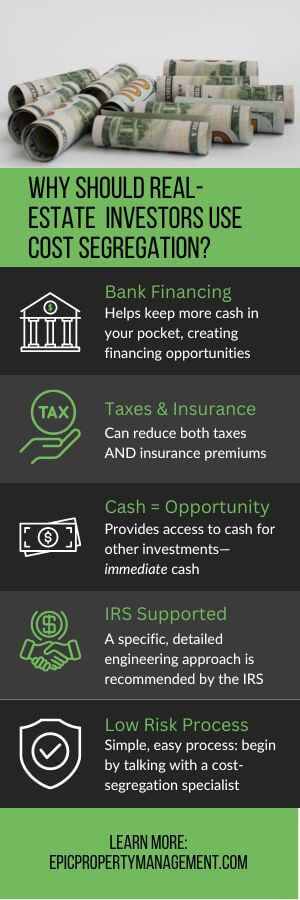Cost segregations can be powerful tools for improving cash flow and profit. But for many real estate investors, the concept is downright daunting. So we invited Terry Judge to enlighten our readers. Terry is an expert in cost segregations and tax incentives, and together with Core Solutions Group, he’s on a mission to help businesses and investors improve cash flow, asset value, and ROI. Let’s lean in and learn from Terry:
In today’s competitive credit markets, it’s important to help property owners improve their financial position and qualify for financing. Enter cost segregations.
Cost segregation is a useful tool that can boost liquidity for many investors. While some people in the real estate world have heard about cost segregations, not everyone fully understands their value and how they can immediately impact cash flow. So today, we’re digging in with a concise, high-value overview.
In this post, I’ll cover:
- The What & How of Cost Segregations
- Qualifying for Cost Segregations
- Why Cost Segregations Are Valuable
In many cases, by understanding and leveraging cost segregations, real estate investors can open up hundreds of thousands of dollars in cash flow. Here’s what you need to know:
The What & How of Cost Segregations
An IRS-supported tax strategy, cost segregation involves reclassifying qualified costs from real property to tangible personal property. This includes categories like
- Plumbing
- Electrical systems
- Mechanical systems
- Millwork
- Carpeting
- Etc.
Cost segregations allow such costs to qualify for accelerated depreciation in the form of larger write-offs against federal income tax. Which means you can pay less in taxes right away—and make more cash available.
Property owners who implement this approach can see substantial business growth, but the process is highly detailed and complex. Which is why the best strategy is to find an excellent tax-engineering partner that
- Displays up-to-the-minute expertise
- Excels in the detailed engineering approach recommended by the IRS
- Provides sample reports for you to examine as you compare options
- Offers audit defense at no charge
When to Do Cost Segregations
To get the maximum tax deductions and cash flow, it’s best to perform a cost-segregation study immediately after purchasing a property.
But there’s also an option to go back to previous years and claim missed deductions. These studies are especially helpful for property owners who want to buy more property or refinance, because it allows you to improve your financial situation, thereby opening up financing opportunities.

It usually takes about 4 to 6 weeks to complete a cost-segregation study.
Qualifying for Cost Segregations
To qualify a property for cost segregation, a few basic requirements come into play:
Tax Payer
The entity that owns the property must be paying federal income taxes.
Cost Basis
For most firms, the cost basis of the property (excluding the land value) must be over $500,000. Some firms set a minimum of $1 million.
Use Date
The property must have been put into use after January 1, 1987.
Property Type
Many property types are eligible, including but not limited to existing property, new construction, leaseholds, properties undergoing renovation, etc.
It’s always a good idea to consult with a professional if you’re unsure whether a property qualifies.
Ownership
Interestingly, property ownership is not necessary for cost segregation, as leaseholders who have spent more than $350,000 on renovations can also qualify.
Retention
Lastly, to fully benefit and avoid recapture, it’s recommended to keep the property for at least 12 to 24 months after the study.
Why Cost Segregations Are Valuable
There are 5 simple reasons why you should consider cost segregations:
1. Bank Financing
By speeding up depreciation and allowing larger deductions for qualified improvements, cost segregations help real estate investors keep more cash in their pockets. This improves your bottom line and increases your ability to qualify for bank financing.
2. Save on Taxes & Insurance
Reclassifying some costs as personal property reduces the amount of real property subject to taxes. This can not only lead to lower property taxes; it also has the potential to lower insurance premiums. All of which leaves you with more cash to work with.
3. Create Opportunity
Cost segregations can provide access to cash for other investments—immediate cash, in fact. It’s a great way to take advantage of the time value of money.
4. Supported by the IRS
The IRS recognizes the importance of qualified professionals conducting cost-segregation studies. Following the IRS guidelines ensures that the findings are considered valid.
5. Low Risk, Easy Process
A cost-segregation study is a simple and low-risk process.
Most firms offer free analyses to determine potential benefits. Once clients decide to proceed, qualified engineers visit the property, assess relevant systems, and document eligible improvements.
Your CPA then receives a comprehensive report that can be implemented right away for immediate benefits.
So why not get started today to learn more?
Pass It On: Cost Segregations and More
Know someone who would be interested in cost segregations or other important about real estate investing and property management tips? Share the link to this post or encourage them to subscribe to our newsletter for future updates.
